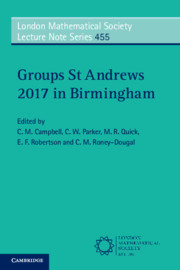Book contents
- Frontmatter
- Contents
- Introduction
- Finite Simple Groups and Fusion Systems
- Finite and Infinite Quotients of Discrete and Indiscrete Groups
- Local-Global Conjectures and Blocks of Simple Groups
- A Survey on Some Methods of Generating Finite Simple Groups
- One-Relator Groups: An Overview
- New Progress in Products of Conjugacy Classes in Finite Groups
- Aspherical Relative Presentations all Over Again
- Simple Groups, Generation and Probabilistic Methods
- Irreducible Subgroups of Simple Algebraic Groups – A Survey
- Practical Computation with Linear Groups Over Infinite Domains
- Beauville p-Groups: A Survey
- Structural Criteria in Factorised Groups Via Conjugacy Class Sizes
- Growth in Linear Algebraic Groups and Permutation Groups: Towards a Unified Perspective
- L2-Betti Numbers and their Analogues in Positive Characteristic
- On the Pronormality of Subgroups of Odd Index in Finite Simple Groups
- Vertex Stabilizers of Graphs with Primitive Automorphism Groups and a Strong Version of the Sims Conjecture
- On the Character Degrees of a Sylow p-Subgroup of a Finite Chevalley Group G(pf) Over a Bad Prime
- Patterns on Symmetric Riemann Surfaces
- Subgroups of Twisted Wreath Products
- Some Remarks on Self-Dual Codes Invariant Under Almost Simple Permutation Groups
- Test Elements: From Pro-p to Discrete Groups
- References
Patterns on Symmetric Riemann Surfaces
Published online by Cambridge University Press: 15 April 2019
- Frontmatter
- Contents
- Introduction
- Finite Simple Groups and Fusion Systems
- Finite and Infinite Quotients of Discrete and Indiscrete Groups
- Local-Global Conjectures and Blocks of Simple Groups
- A Survey on Some Methods of Generating Finite Simple Groups
- One-Relator Groups: An Overview
- New Progress in Products of Conjugacy Classes in Finite Groups
- Aspherical Relative Presentations all Over Again
- Simple Groups, Generation and Probabilistic Methods
- Irreducible Subgroups of Simple Algebraic Groups – A Survey
- Practical Computation with Linear Groups Over Infinite Domains
- Beauville p-Groups: A Survey
- Structural Criteria in Factorised Groups Via Conjugacy Class Sizes
- Growth in Linear Algebraic Groups and Permutation Groups: Towards a Unified Perspective
- L2-Betti Numbers and their Analogues in Positive Characteristic
- On the Pronormality of Subgroups of Odd Index in Finite Simple Groups
- Vertex Stabilizers of Graphs with Primitive Automorphism Groups and a Strong Version of the Sims Conjecture
- On the Character Degrees of a Sylow p-Subgroup of a Finite Chevalley Group G(pf) Over a Bad Prime
- Patterns on Symmetric Riemann Surfaces
- Subgroups of Twisted Wreath Products
- Some Remarks on Self-Dual Codes Invariant Under Almost Simple Permutation Groups
- Test Elements: From Pro-p to Discrete Groups
- References
Summary
We are interested in regular maps on compact symmetric Riemann surfaces. A surface is symmetric if it admits an antiholomorphic involution (symmetry). The fixed-point set of this symmetry is a collection of simple closed curves called mirrors. These mirrors pass through the vertices, edge-centres and face-centres of the map forming a sequence which we call a pattern. Klein in 1879 calculated the pattern for the Riemann surface named after him. Here we discuss the patterns for various families of Riemann surfaces, ending with the Hurwitz surfaces, these admitting 84(g − 1) automorphisms.
- Type
- Chapter
- Information
- Groups St Andrews 2017 in Birmingham , pp. 443 - 454Publisher: Cambridge University PressPrint publication year: 2019



